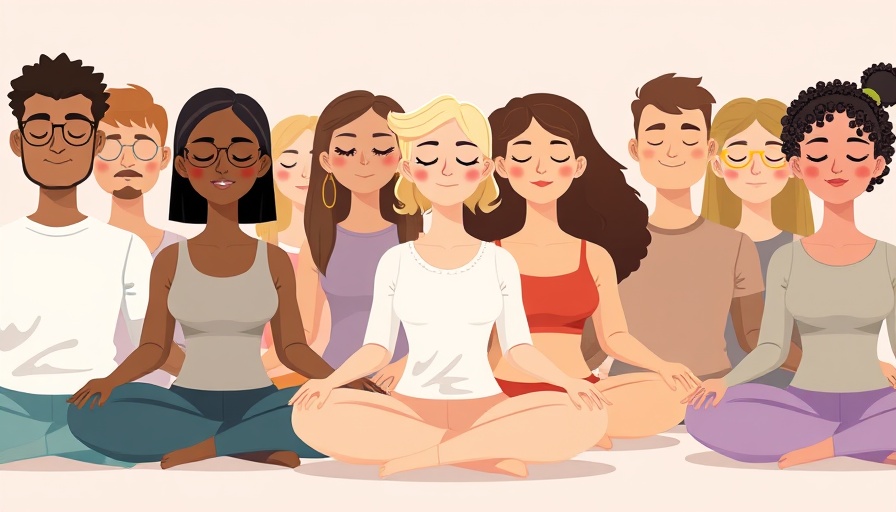
The Essence of Mindfulness: More Than Just a Buzzword
Mindfulness is often described as a state of awareness where you can fully engage in the present moment. But what does this mean, and why should it matter to you? In its most straightforward definition, mindfulness encourages individuals to focus on what is happening right now—both within their bodies and in their surroundings—without getting lost in thoughts about the past or future. For busy adults juggling numerous responsibilities, being mindful can act as an anchor amidst life's chaos.
The Many Faces of Mindfulness
There are several ways to practice mindfulness, making it accessible for everyone. Here are some popular forms:
- Seated Meditation: Sit comfortably with a straight spine, focusing on your breath. This practice can help improve concentration and reduce stress.
- Walking Meditation: Walk slowly while paying attention to each step and the sensation it brings. This method can be combined with outdoor activities like hiking or jogging.
- Mindful Movement: Integrate mindfulness into activities like yoga or dance, where body awareness is essential. These practices encourage a connection between body and mind.
The Undeniable Benefits of Incorporating Mindfulness Into Your Life
Practicing mindfulness offers a variety of benefits that can enhance your quality of life. Studies have shown that regular mindfulness meditation can:
- Decrease levels of stress and anxiety, paving the way for a calmer outlook on life.
- Improve emotional regulation, enabling individuals to respond rather than react to challenging situations.
- Enhance cognitive performance by improving focus and attention span, making daily tasks more manageable.
In a world that constantly demands our attention, cultivating mindfulness can significantly improve our well-being. Whether it’s during your hectic morning rush or a moment of pause at work, integrating mindfulness practices can lead to enhanced mental clarity and emotional resilience.
Mindfulness in Motion: Everyday Integration
Mindfulness doesn’t have to be confined to quiet meditation sessions. It can be interwoven into your daily routine. Here are some practical insights:
- Pause and Breathe: Take brief moments throughout your day—like waiting for your coffee to brew or sitting in traffic—to bring attention to your breath. This practice reconnects you with the present.
- Mindful Meals: Engage all your senses during meals—what do you smell? What flavors do you taste? This not only improves your eating experience but can also support healthier choices.
- Movement Awareness: Whether during exercise or simple tasks, paying attention to your body's movements can turn routine actions into meditative experiences.
Future Trends: The Growing Popularity of Mindfulness
As our understanding of mental health evolves, mindfulness continues to grow as a popular trend. Many corporations and schools are beginning to integrate mindfulness programs, recognizing its positive impact on stress reduction and productivity. In the future, mindfulness-based approaches may become commonplace in health care, education, and even corporate wellness programs, highlighting the importance of mental and emotional well-being.
Common Misconceptions About Mindfulness
Despite its benefits, many misconceptions surround mindfulness practice. A common myth is that mindfulness requires clearing your mind completely. In truth, it's more about observing thoughts without judgment rather than eliminating them.
Another misconception is that mindfulness is only for specific types of people, like yogis or spiritual practitioners. The reality is that everyone can reap the benefits of mindfulness regardless of age, lifestyle, or background.
Your Path to Mindfulness: Taking Action
If you’re ready to explore mindfulness, consider starting small. Set aside just five minutes a day to practice one of the methods outlined above. By dedicating this time to yourself, you’re taking a step towards greater health and well-being.
Mindfulness is an invaluable tool that everyone can utilize to enhance their lives. Try integrating these practices into your daily routine, and watch how they positively influence your perspective and everyday experiences.
For those seeking a structured approach, many resources are available, from apps to local classes. Engaging with a community can offer additional support and motivation.
Mindfulness enhances not just our perception but also our capacity to navigate the complexities of life with more grace and ease. So why not give it a try? Start today, and discover the serenity that mindfulness can bring.
 Add Row
Add Row  Add
Add 




Write A Comment